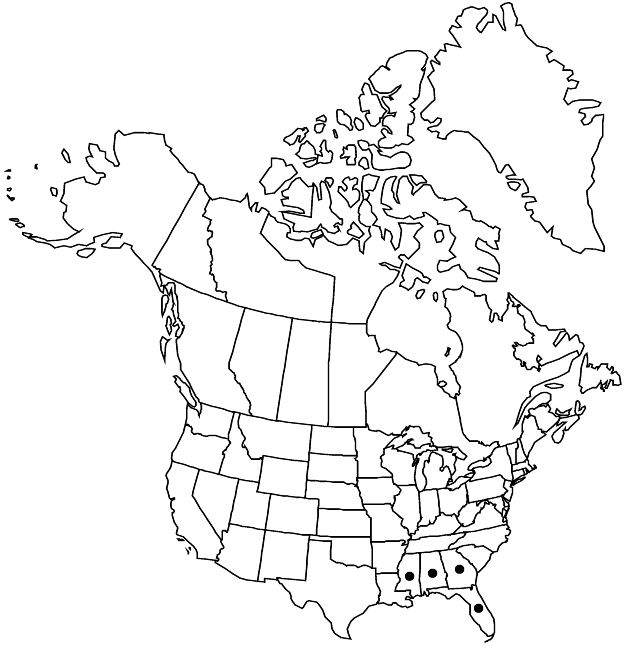Difference between revisions of "Crataegus sargentii"
Bot. Gaz. 28: 407. 1899.
FNA>Volume Importer |
imported>Volume Importer |
||
| (6 intermediate revisions by 2 users not shown) | |||
| Line 28: | Line 28: | ||
|elevation=20–300 m | |elevation=20–300 m | ||
|distribution=Ala.;Fla.;Ga.;Miss. | |distribution=Ala.;Fla.;Ga.;Miss. | ||
| − | |discussion=<p>Crataegus sargentii is mainly from Alabama, extending west to central Mississippi, eastwards with scattered records from Georgia, and south to the panhandle of Florida; it is locally common. Anthesis is three weeks later in the Alabama canyonlands than on the Gulf Coast. The species is most similar to C. gilva; the latter has narrower leaves and smaller pomes. Occasional more deeply incised forms may resemble other species to some extent; they will usually retain the characteristic overall leaf shape of the species.</p> | + | |discussion=<p><i>Crataegus sargentii</i> is mainly from Alabama, extending west to central Mississippi, eastwards with scattered records from Georgia, and south to the panhandle of Florida; it is locally common. Anthesis is three weeks later in the Alabama canyonlands than on the Gulf Coast. The species is most similar to <i>C. gilva</i>; the latter has narrower leaves and smaller pomes. Occasional more deeply incised forms may resemble other species to some extent; they will usually retain the characteristic overall leaf shape of the species.</p> |
|tables= | |tables= | ||
|references= | |references= | ||
| Line 37: | Line 37: | ||
-->{{#Taxon: | -->{{#Taxon: | ||
name=Crataegus sargentii | name=Crataegus sargentii | ||
| − | |||
|authority=Beadle | |authority=Beadle | ||
|rank=species | |rank=species | ||
| Line 52: | Line 51: | ||
|publication year=1899 | |publication year=1899 | ||
|special status=Endemic | |special status=Endemic | ||
| − | |source xml=https:// | + | |source xml=https://bitbucket.org/aafc-mbb/fna-data-curation/src/2e0870ddd59836b60bcf96646a41e87ea5a5943a/coarse_grained_fna_xml/V9/V9_989.xml |
|subfamily=Rosaceae subfam. Amygdaloideae | |subfamily=Rosaceae subfam. Amygdaloideae | ||
|tribe=Rosaceae tribe Gillenieae | |tribe=Rosaceae tribe Gillenieae | ||
Latest revision as of 23:00, 5 November 2020
Shrubs or trees, 30–50 dm. Stems: twigs: new growth reddish, 1-year old shiny, deep reddish brown, 2-years old grayish red, older gray; thorns on twigs few to numerous, straight to slightly recurved, 2-years old black, slender, 2–5 cm. Leaves: petiole length 25–40% blade, sparsely sessile-glandular; blade ovate-trullate, 4–6(–7) cm, terminal 1/2 ± straight-sided across lobe tips, base rounded to broadly cuneate, lobes 0 or 1–3 per side, barely present or sinuses shallow, LII 0–20%, lobe apex acute, margins serrulate, teeth to 1 mm, veins 5–7 per side, apex acute to acuminate, abaxial veins sparsely hairy young. Inflorescences 4–10(or 11)-flowered; branches glabrous; bracteoles caducous, numerous, often ± curved, green, linear, membranous to subherbaceous, margins glandular. Flowers 15–18 mm diam.; sepals narrowly triangular, 3 mm, base flaring to wide, margins entire or glandular-denticulate, apex ± obtuse, abaxially glabrous; anthers pale pink to pale purple; styles 3 or 4. Pomes yellow or flushed pink, sometimes reddish, suborbicular, 8–10(–12) mm diam.; sepals on collar, reflexed; pyrenes 3 or 4. 2n = 34, 51.
Phenology: Flowering late Mar–mid Apr; fruiting Sep–Nov.
Habitat: Woodland edges, cut-over woodlands, other open woodlands
Elevation: 20–300 m
Distribution

Ala., Fla., Ga., Miss.
Discussion
Crataegus sargentii is mainly from Alabama, extending west to central Mississippi, eastwards with scattered records from Georgia, and south to the panhandle of Florida; it is locally common. Anthesis is three weeks later in the Alabama canyonlands than on the Gulf Coast. The species is most similar to C. gilva; the latter has narrower leaves and smaller pomes. Occasional more deeply incised forms may resemble other species to some extent; they will usually retain the characteristic overall leaf shape of the species.
Selected References
None.